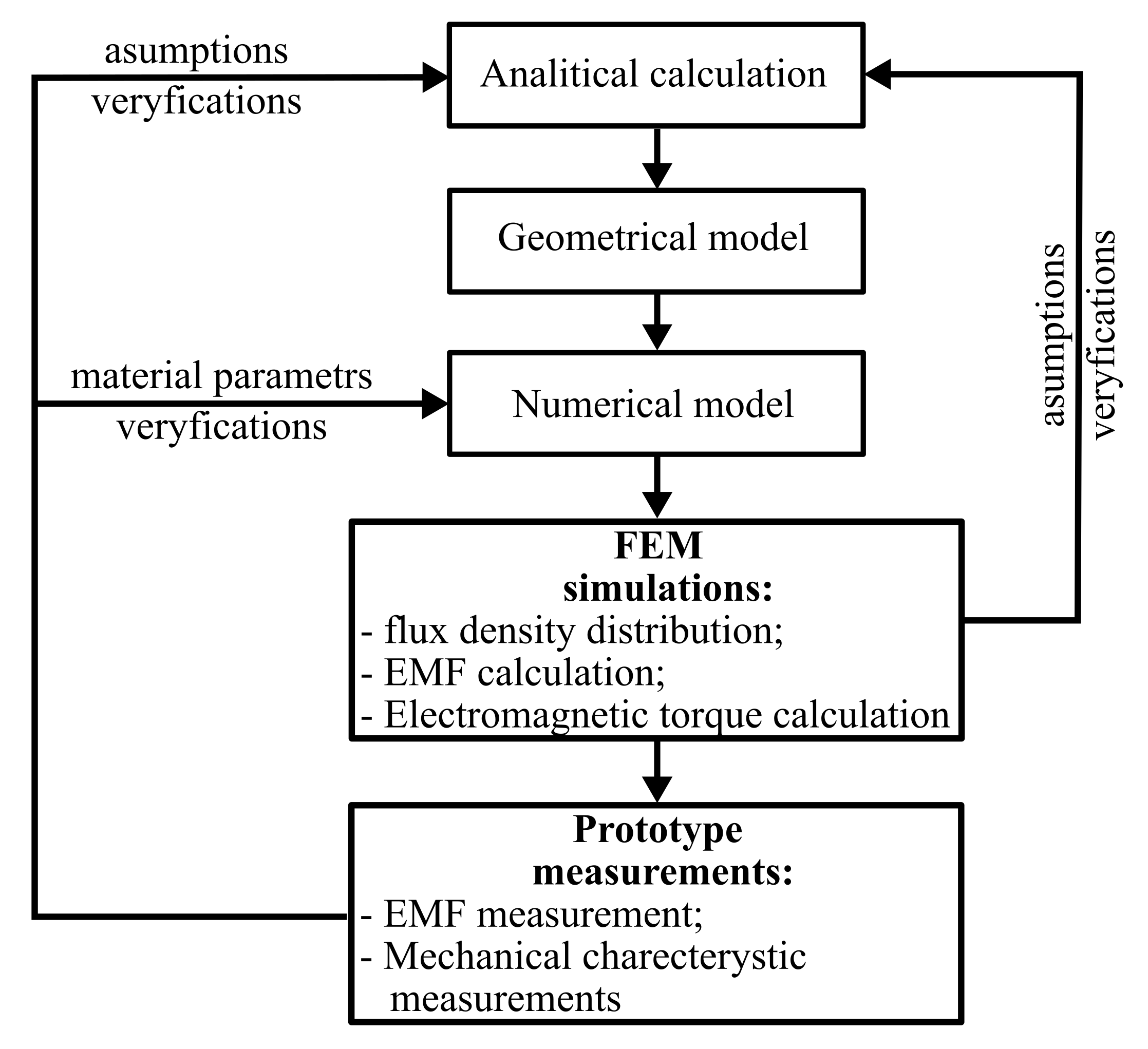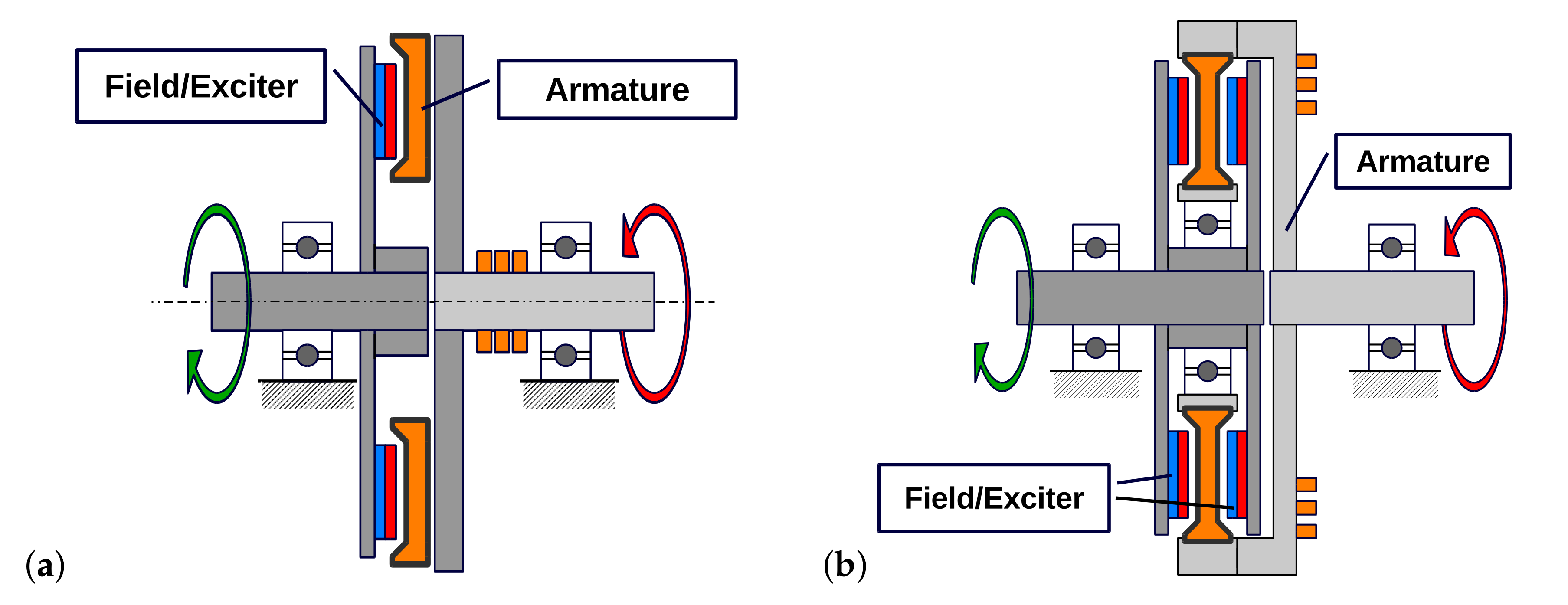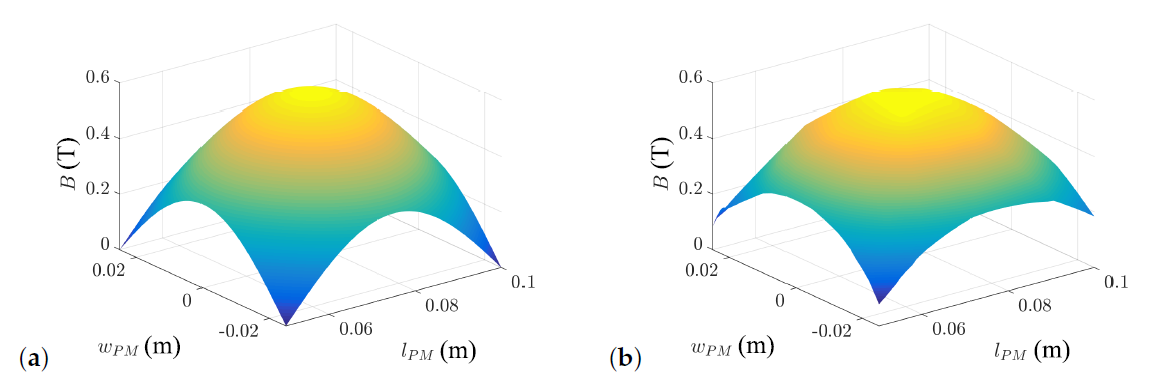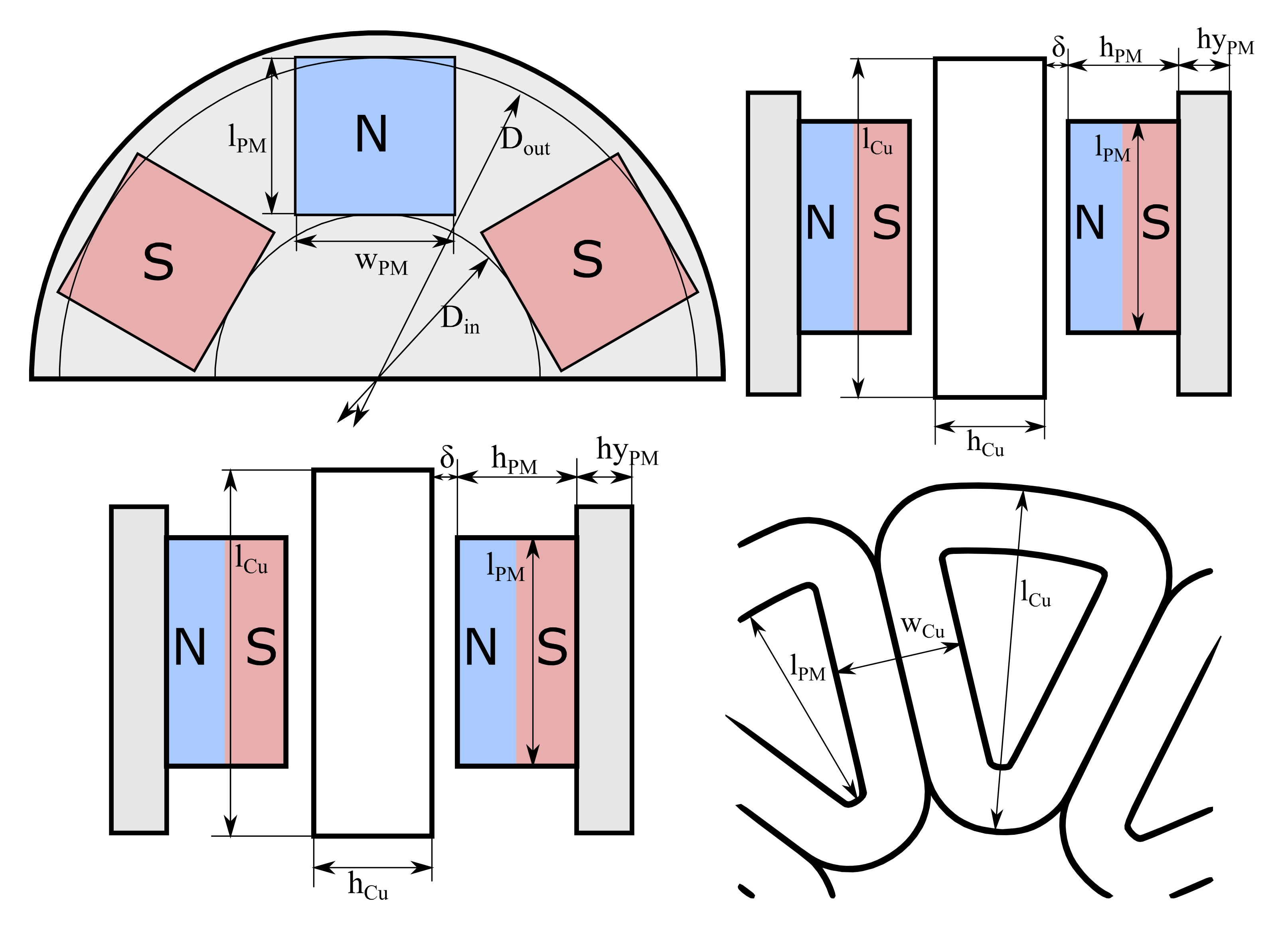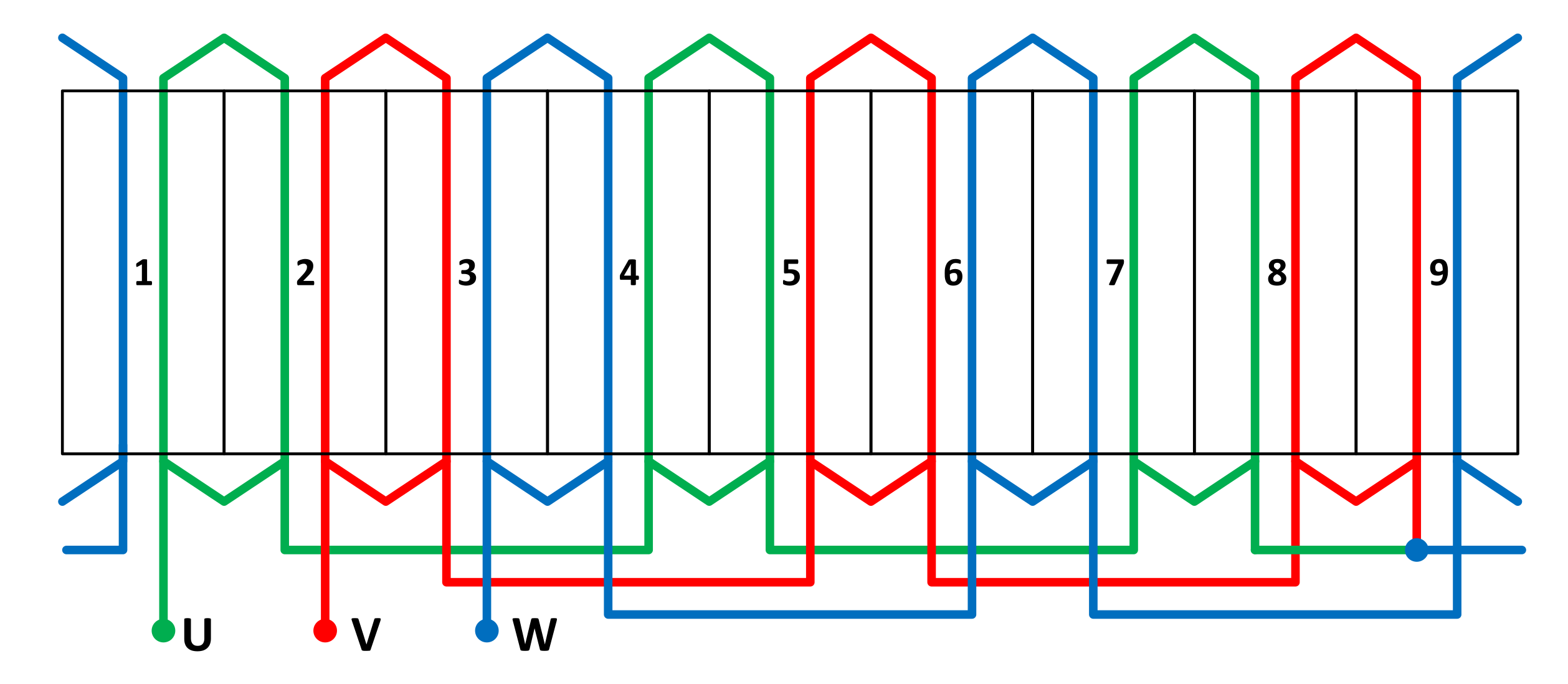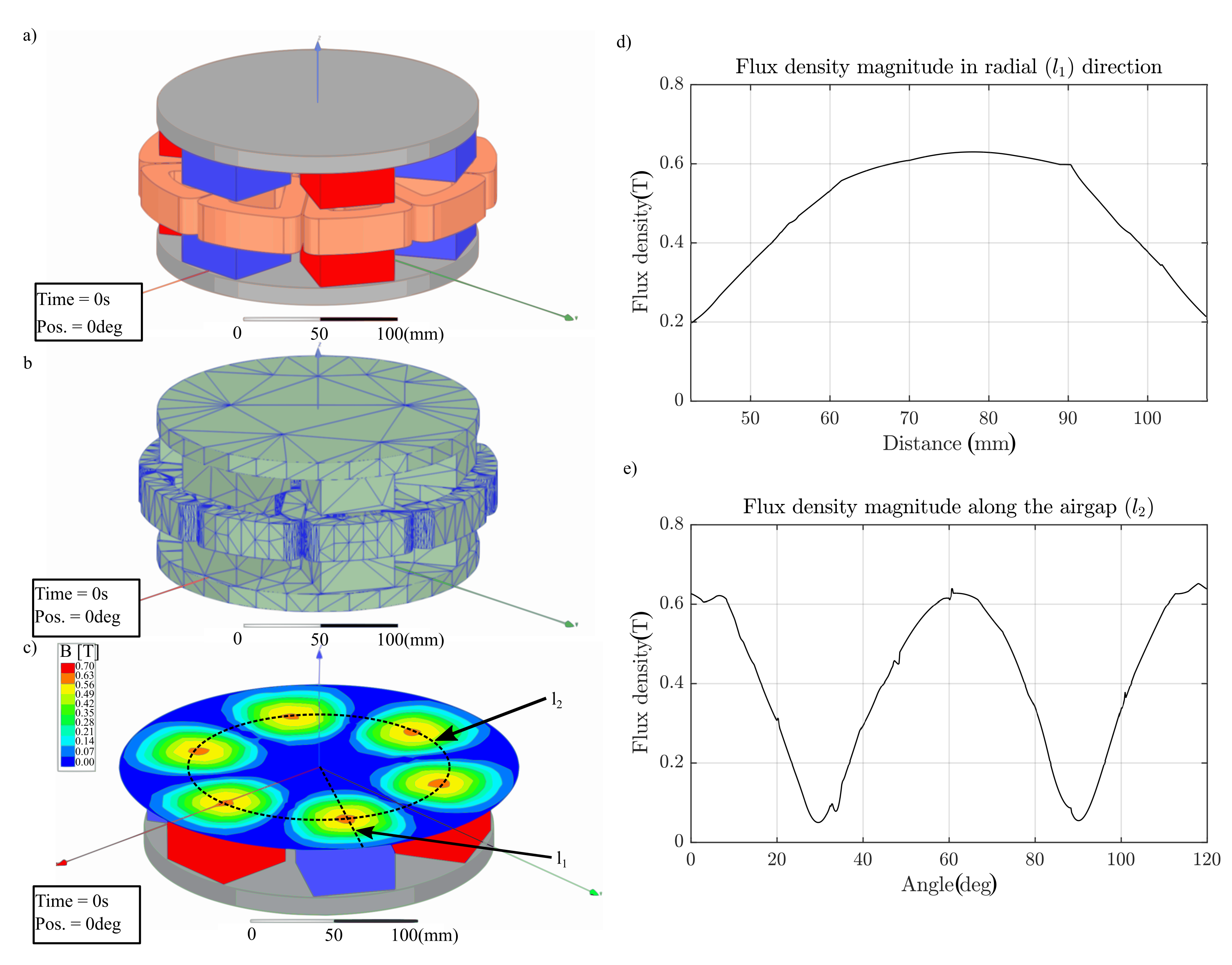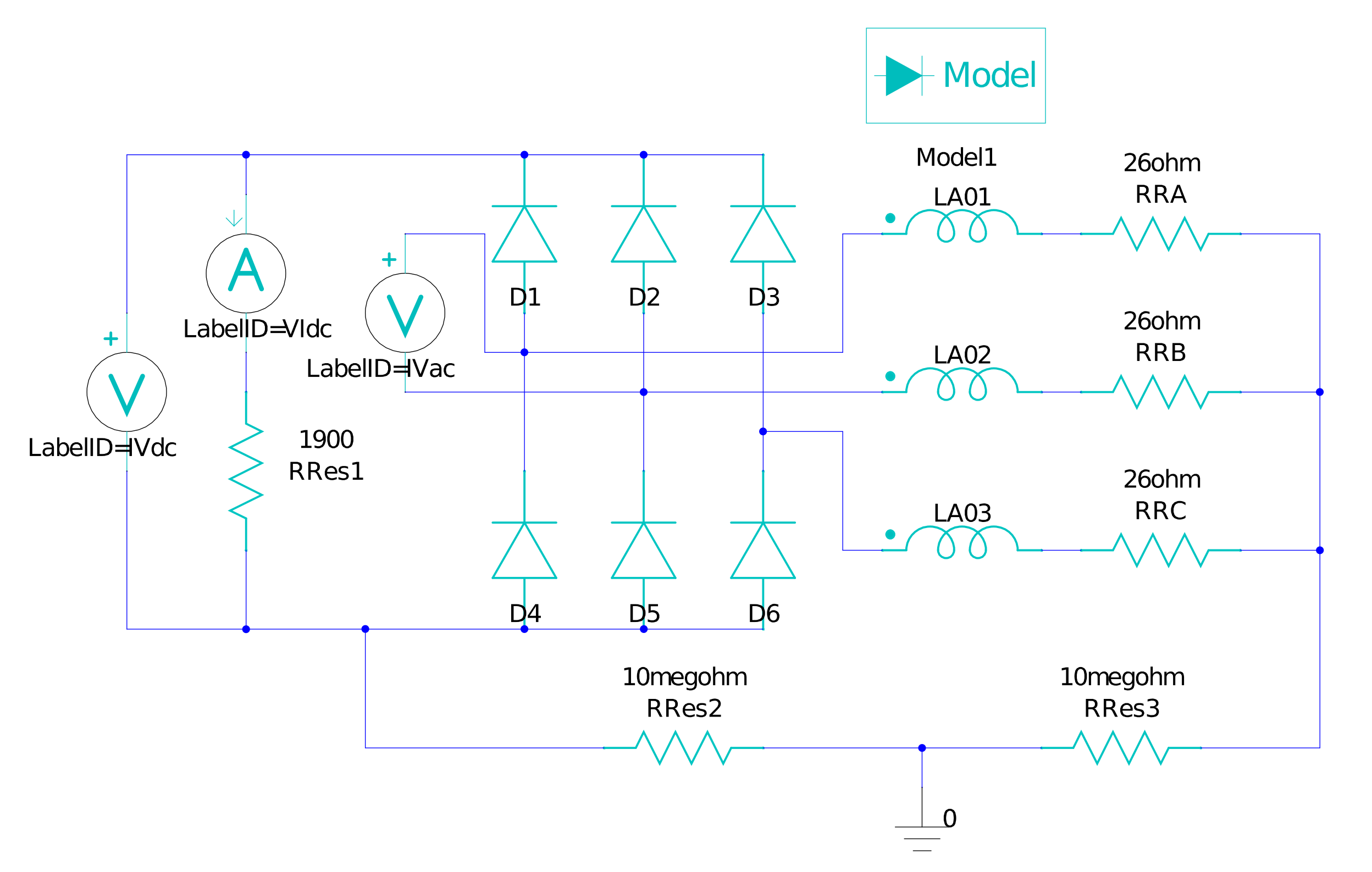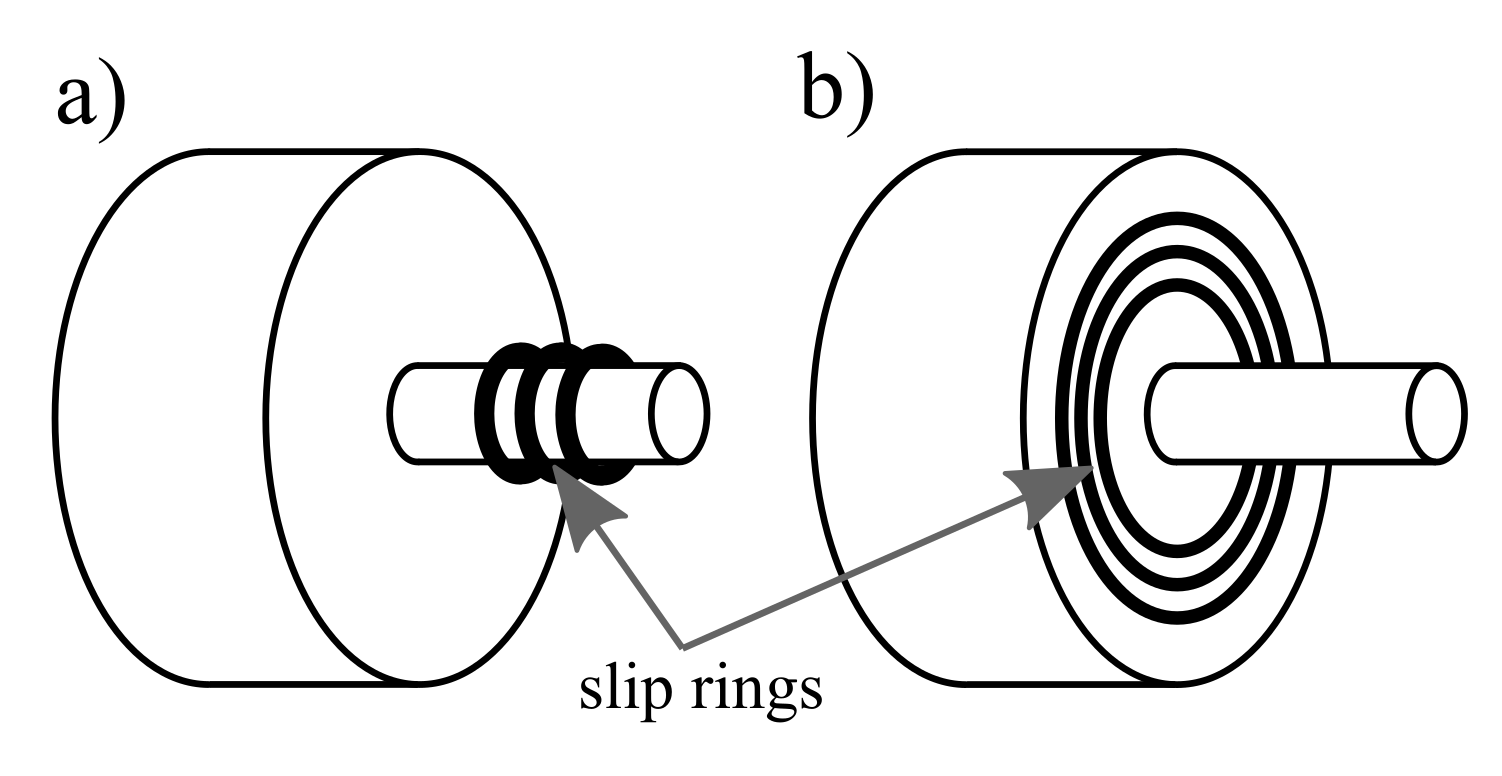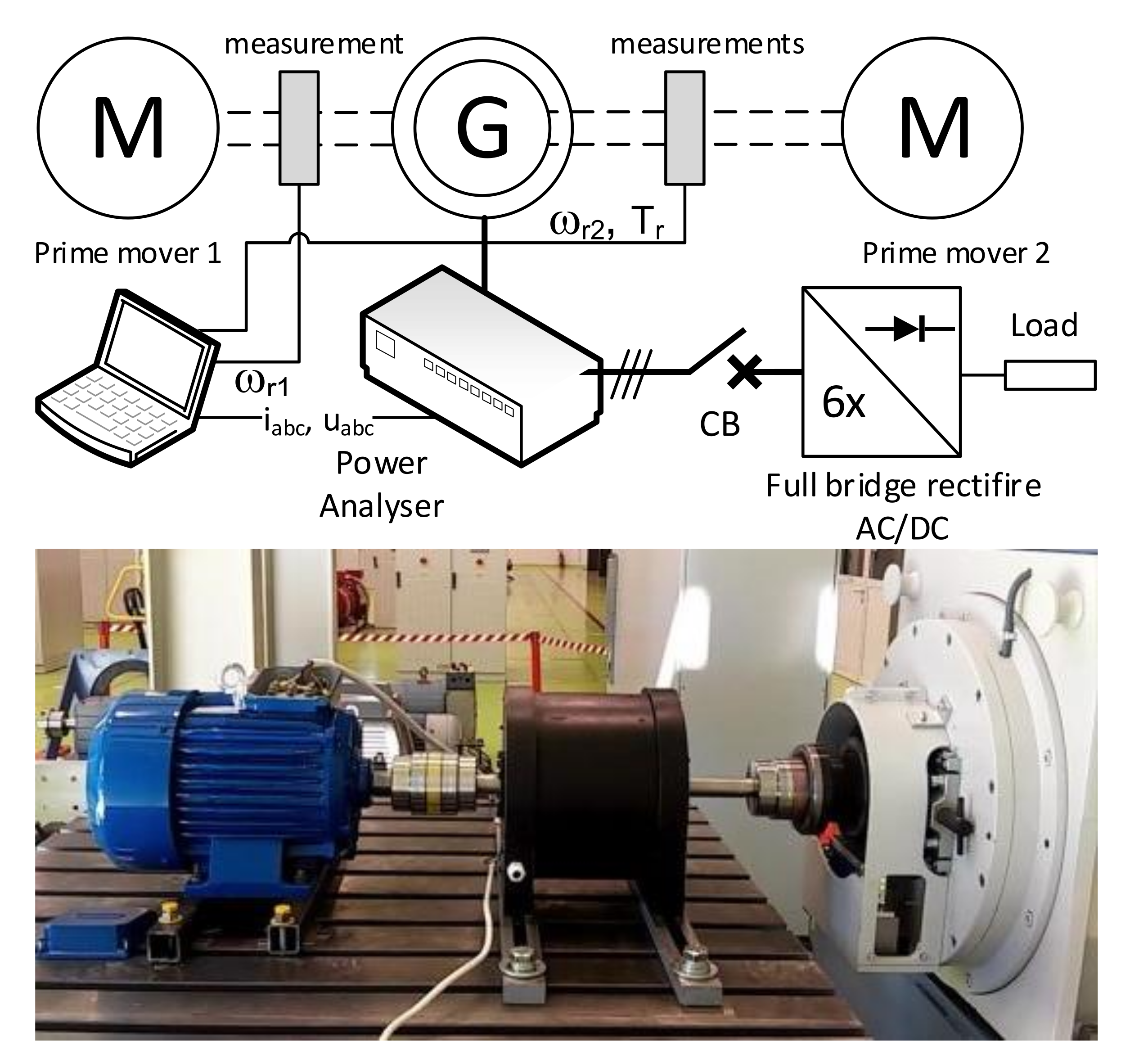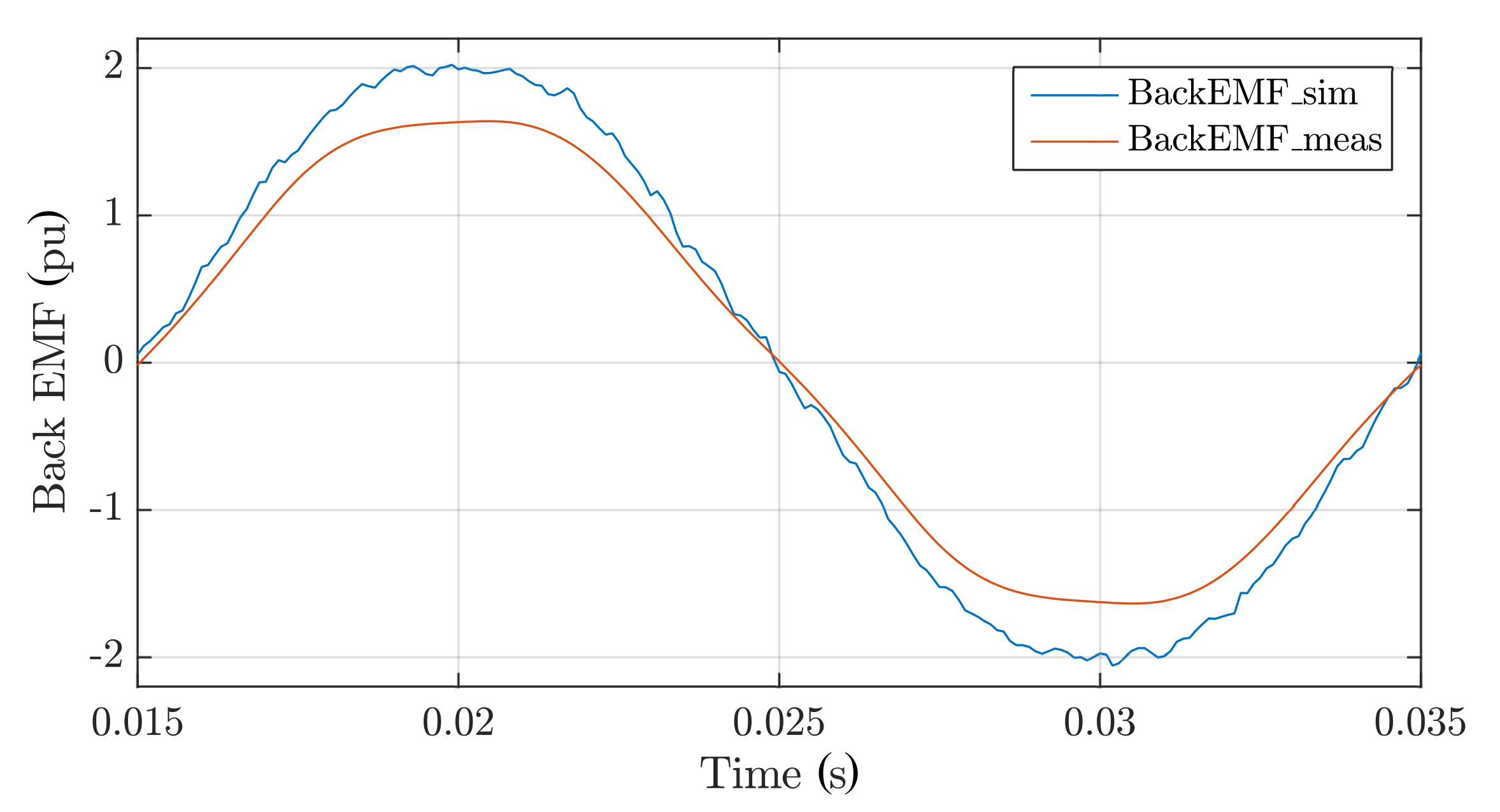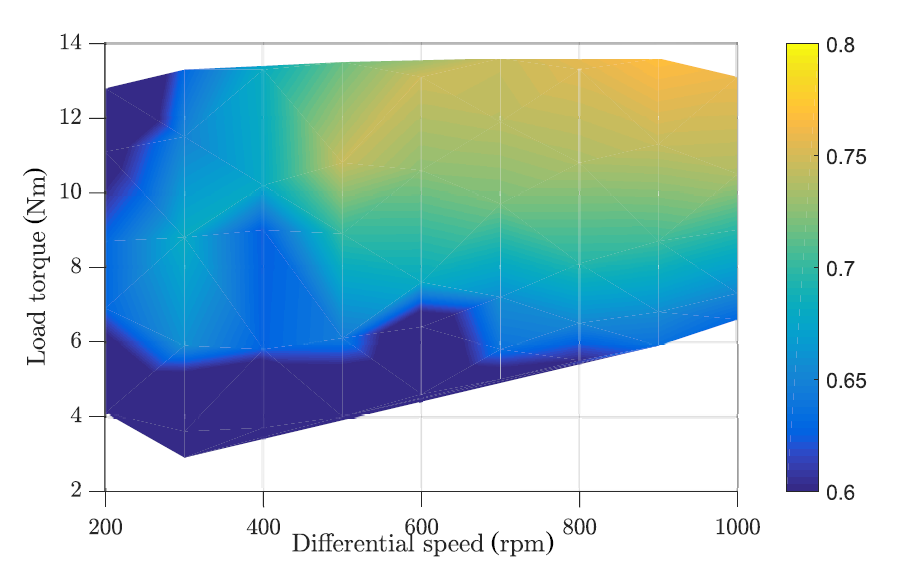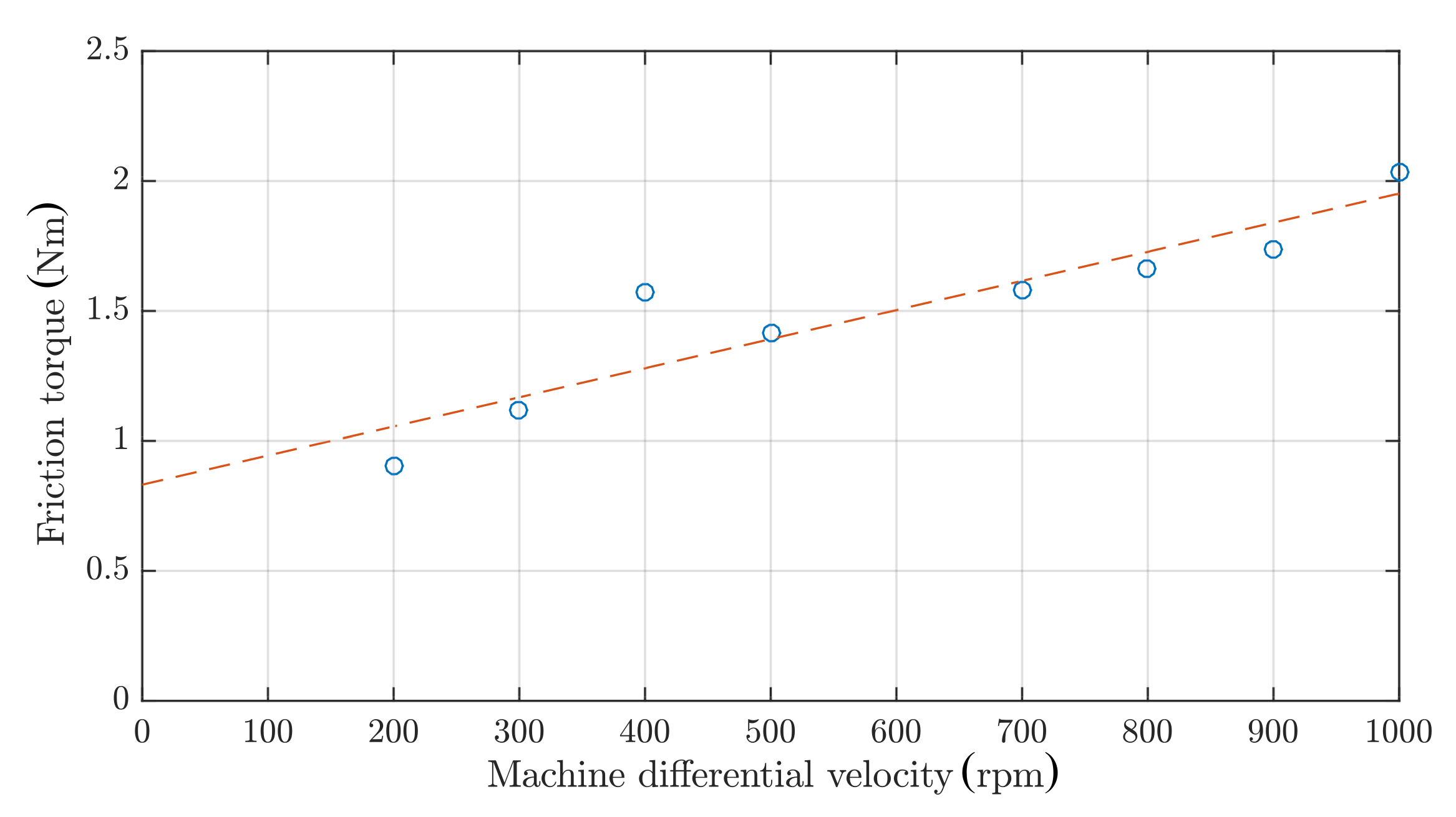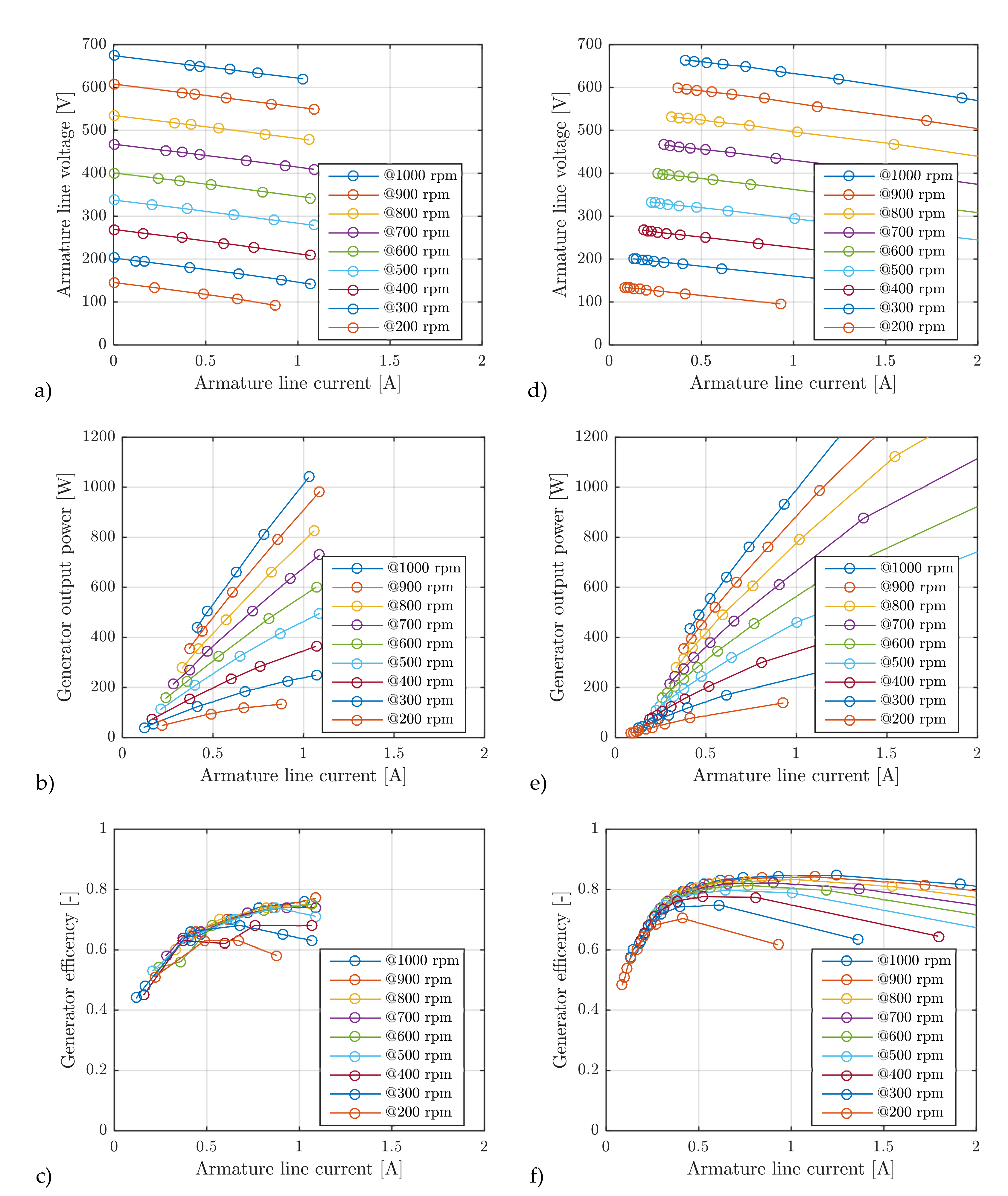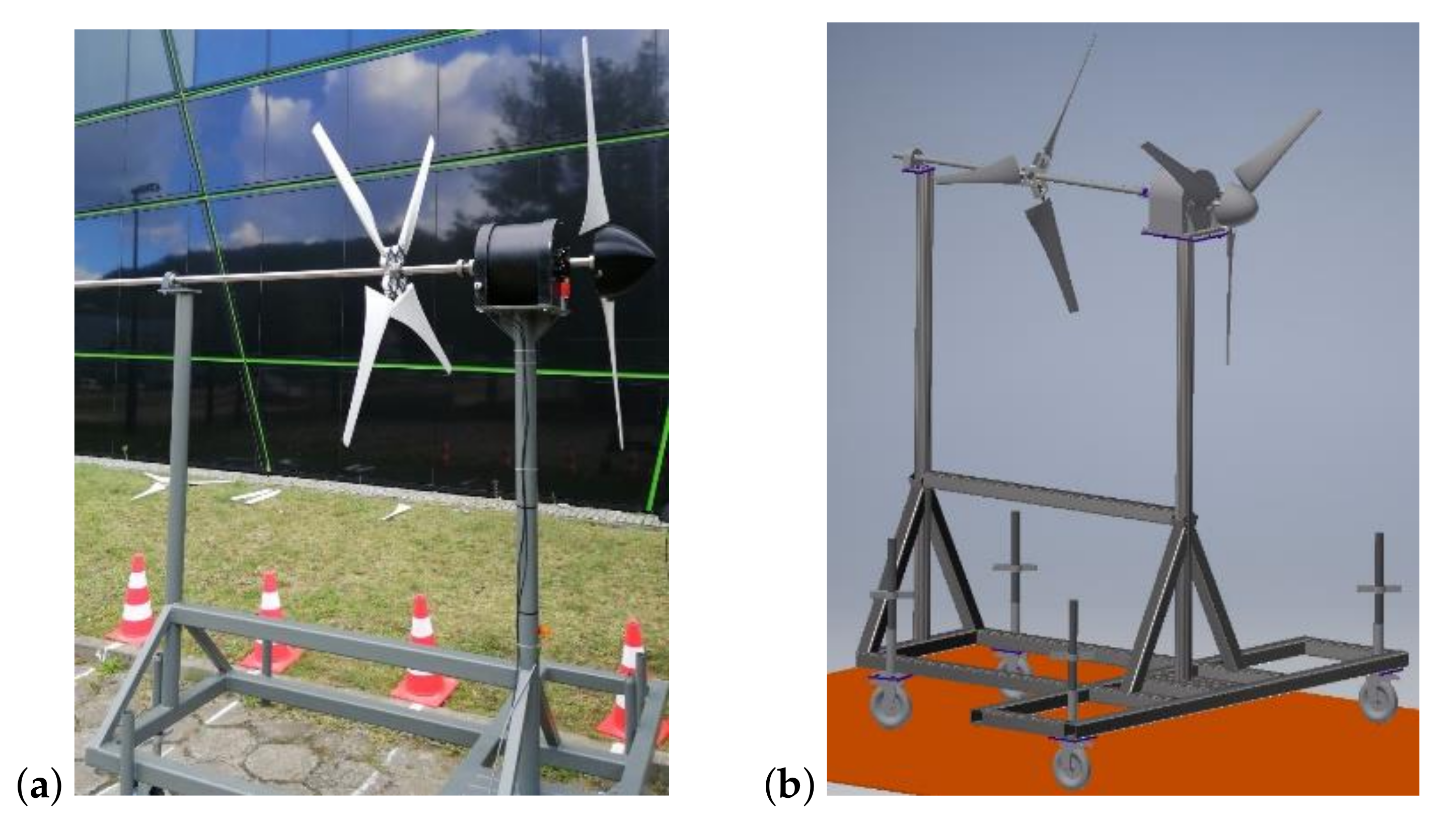The electromagnetic structure of the dual rotor machine can be divided into two main groups:
The objective of the research was to develop a novel axial flux permanent magnet generator that would take advantage of the dual rotor wind turbine concept. In typical permanent magnet generators, the field source, also known as the exciter, is the rotor and the armature is the stator. In the proposed construction, the field, as well as the armature, are both two independent rotors of the machine. That means they can revolve independently of each other and the stator. The axial flux machine type was selected for the generator design. This type of machine allows for relatively high torque-to-volume ratio. The main contribution of the research is the novel construction of the dual rotor axial flux permanent magnet generator.
2.1. Analytical Calculation of the Machine Dimensions
The general approach in machine design is based on the sizing equation. For the axial flux machine, this equation is defined as:
where:
is the external diameter of the PM,
is the output power of the machine (mechanical power in the case of motor, electrical power in the case of generator),
is the winding factor for the fundamental component of the winding magnetomotive force (MMF),
is the machine rotational velocity (in the case of the dual rotor machine, it is differential rotational velocity between two rotors),
is the amplitude of the air gap flux density normal component,
is the amplitude of the linear current density,
is the power factor of the machine,
is the efficiency of the machine and the
is defined based on the ratio of the internal PM diameter
to the external PM diameter
:
As can be noticed, the power of the machine is dependent on the machine rotational velocity and the product of linear current density and air gap flux density, which determines the air gap tangential stress or the torque. For set rotational velocity, power is defined by the torque, which in turn is dependent on the machine external diameter cubed.
The axial flux machines are known for their large diameter in relation to machine length. Which makes them suitable for low speed, high torque solutions. In order to increase the power density of the proposed solution, an axial flux machine with counter-rotating field and coreless armature has been proposed. In the axial flux machine with a coreless armature and dual permanent magnet disc-shaped field, the exciter is usually made out of construction mild steel or carbon steel with permanent magnets glued to its surface. This carbon steel magnetic core has much lower relative magnetic permeability (40 to 100 times lower) than electrical or lamination steel. However, in a machine with a coreless armature, this does not affect the machine performance. This type of construction is very popular due to the fact that it is very easy to manufacture even without any advanced equipment. Because of the coreless armature, the power density is reduced. However, in axial flux machines, the power is proportional to its diameter cubed. In low power machines, even a small increase in the diameter can compensate for the lower power density of the coreless design. In addition, a dual PM exciter disc solution allows increasing the flux linkage of coreless armature machines.
Figure 3 shows the single and dual exciter construction of the dual rotor axial flux machine.
In the sizing Equation (
1), the rotational velocity ns is the relative velocity between the excitation and the armature. In the proposed solution of the machine with a rotating field and armature, each of these components will rotate in the opposite direction powered by a separate wind turbine. The resulting relative velocity will be the sum of the speed of the field and the armature in reference to the machine enclosure.
The machine three phase winding constructions consist of nine coils. Three coils are connected in series in each phase. The winding is a fractional slot winding or the tooth coil winding type where the number of slots per pole and per phase is 0.5. The number of winding turn per phase was calculated based on the machine flux linkage:
where
is the ratio of machine phase-to-phase back EMF Ef to the fundamental component of machine voltage,
is the electrical rotational velocity (
, where
p is the number of pole pairs) and
is defined as:
and for the generator
. The
is the amplitude of flux linkage and is calculated based on the magnitude of air gap flux density, the slot pitch and the external and internal diameter of the machine:
where
is the slot pitch and
is the air gap flux density distribution factor as a ratio between the average and maximum value of the air gap flux density. The machine has coreless armature and relatively high value of PMs height in reference to pole pitch. Because of that, the air gap flux distribution along the width (
) and the length (
) of the PM is close to sinusoidal and can be defined as:
Based on this, the air gap flux density distribution factor can be defined as:
This coefficient value was later verified using FEM simulations. The expected distribution of the normal component of air gap flux density between two magnets in the coreless armature is presented in
Figure 4.
The material used for the exciter rotor was construction milled steel S355 and the PM material is the N40. The general dimensions calculated during the design process are shown in
Figure 5.
The magnetic or effective air gap length is defined as:
where
is construction/manufacturing air gap and
is the armature height or the winding/slot height in the case of the coreless armature axial flux machine. Based on the maximum value of air gap flux density, the air gap length and the permanent magnet parameters at the operational temperature, the height of the PM is calculated:
where
is the magnetic relative permeability of PM,
is the PM fill coefficient (defines the ratio between PM volume and PM specific material in that volume) and
is the remanence flux density of the PM.
Figure 6 shows the winding construction of the designed machine.
Calculated machine dimensions are shown in
Table 1.
2.2. FEM Analysis
The FEM analysis was used in order to verify the analytical calculation of the machine dimensions. In order to do that, two main tests were conducted:
In order to perform the simulation, a model in ANSYS Maxwell environment was developed.
Figure 7 shows the geometry of the machine in the FEM software as well as the mesh discretisation and an example of the simulation results. The basic process of the FEM simulation model development consists of the definition of geometry, the definition of materials and the definition of boundaries and excitations. Because of the coreless armature and material used for the PM rotor core (S355 construction steel) the relative magnetic permeability of
was used for the ferromagnetic PM rotor core during the simulations. A separate issue concerns the discretisation of the geometry also known as the mesh generation. In the Maxwell environment of the ANSYS software as in many other FEM simulations software, this step can be automated and left for the software default optimisation strategy based on the allowable error level of the performed simulation. It has to be considered in the design process that coreless armature of the machine creates a large air gap in reference to the armature length (in this case this length is understood as the length of the PM). This results in a decreased value of the average flux density of the flux linkage in the machine. In a typical machine with a small air gap length in reference to the length of the machine, the relation between the average and maximum flux density in the air gap for sinusoidal flux density distribution is defined as
.
However, in the case of the coreless axial flux machine, this value is decreased and influenced by several factors like the shape of PM, the direction of magnetisation of PM, the ratio between the air gap length and the length of the machine and the MMF of the machine winding. Using FEM simulation and results presented in
Figure 3, one can estimate the relationship between the average and maximum flux density to be
.
For the model verification, a transient simulation of the designed machine was conducted. For this simulation, a circuit model was defined in ANSYS Maxwell software.
Figure 8 shows the circuit model. The winding resistances RRA, RRB and RRC have been calculated based on the design demotions of the machine coils. A series of simulations in which the machine velocity and the load resistance RRes1 were changing have been conducted. The differential velocity changed from 100 to 1000 rpm and the load resistance changed from 100 to 1900 ohms
The results of the simulations are shown in the next section of the paper, where they are compared with the measurements.
2.3. Experimental Verification of the Prototype Design
The generator prototype was constructed by the EMS Electric Motors Service Company, Poland. The key aspect in the prototype development was the mechanical construction of two rotating components of the generator. Sturdy construction was achieved using two points of contact between both rotors via the placement of the bearing between the inner and outer rotor.
Figure 9 shows the internal structure of the prototype machine and transverse cross-section.
One of the key aspects apart from the mechanical decoupling between both rotors was the issue of the electrical energy transfer between the armature rotor and the terminal box of the generator. Generally in AC machines, a set of slip rings is used to supply or draw power from the rotating part of the machine, whether it is a synchronous machine with DC excitation winding on the rotor supplied via two slip rings or it is an ac induction machine with three phase wounded rotor and three slip rings. Usually, the slip rings are placed side by side on the shaft of the machine (
Figure 10). In the case of the proposed dual rotor axial flux machine, the slip rings are in the form of concentric rings to which the brushes are spring-loaded parallel to the axis of the machine. The advantage of this approach is the smaller overall length of the machine, however, the disadvantage is the increase in the mechanical losses due to the friction in slip rings and much larger diameter of slip rings than in typical ac machines.
The experimental analysis of the prototype generator has been conducted in the laboratory. The dynamometer test stand equipped with HBM T40B type of torque sensor was used in the measurements. In addition, a second motor equipped with an encoder for speed measurement was used to move the second rotor of the generator. The electrical parameters of the generator were measured using a ZES LMG670 type of power analyser.
Figure 11 shows the simplified measurement test stand schematic and dual-rotor generator test on the dynamometer test bench.
Conducted measurements included the back EMF waveform measurement of line-to-line voltage of the generator (
Figure 12). Also, the efficiency of the prototype generator was measured for selected differential speeds between the rotors and selected load conditions.
Figure 13 shows the measured efficiency of the prototype generator.
In order to compare the electromagnetic FEM simulations and measurements, mechanical losses had to be incorporated into the FEM results. The static and dynamic friction calculated based on the measurements in load and no load conditions for different relative rotational velocities torque has been added to the simulation.
Figure 14 shows the friction torque in the function of differential speed.
The results of FEM simulations and measurements are shown in
Figure 12. The line-to-line voltage, output electrical power and the efficiency ware calculated from both measurements and simulations. The efficiency calculated from the FEM simulation included measured static and dynamic friction:
where
is electromagnetic torque developed by the simulated machine,
and
represent the dynamic and static component of friction torque (
Figure 14) and
is the output electrical power of the generator.
The presented result of the simulation and measurements in
Figure 12 and
Figure 15 indicate a significant difference between the simulations and measurements. The higher calculated efficiency can be caused by both the higher value of induced EMF and also the omission of additional losses due to AC resistance and eddy currents in ferromagnetic construction elements of the machine. The lower value of induced EMF can be caused by:
Different PM parameters the assumed/selected in the calculations,
Different than designed coil dimensions/layout,
Additional leakage flux caused by the ferromagnetic components of the machine construction (shafts, bolts, etc.).

